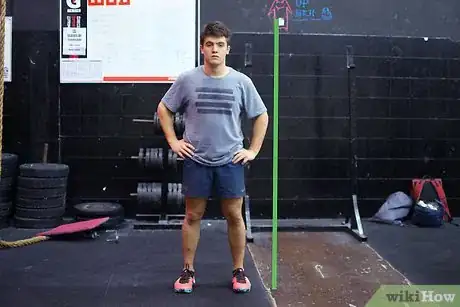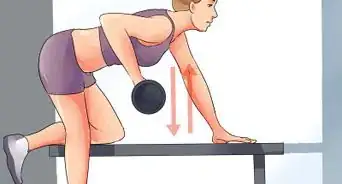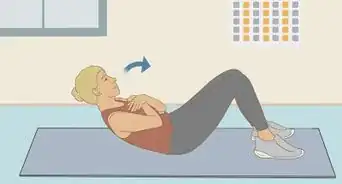This article was co-authored by Francisco Gomez. Francisco Gomez is the Head Coach at the FIT Potato Gym, a training gym established in 2001 in the San Francisco Bay Area. Francisco is a former competitive runner who helps endurance athletes train for major marathons like the Boston Marathon. Francisco specializes in Injury Rehab, Flexibility, Marathon Training, and Senior Fitness. He has a B.S. in Nutrition and Exercise Physiology & Running.
There are 11 references cited in this article, which can be found at the bottom of the page.
wikiHow marks an article as reader-approved once it receives enough positive feedback. In this case, 84% of readers who voted found the article helpful, earning it our reader-approved status.
This article has been viewed 625,536 times.
Lunges are an easy and efficient exercise to help build strength in your quadriceps, glutes, hamstrings, calves, and core. They are also relatively safe to do as they have simple movements that are easy to follow, and lunges require no special equipment to complete. Lunges are also great to help you improve your balance, increase your hip flexibility, develop better coordination, build muscle size and strength, improve spine health, enhance your core stability, and tone a good variety of muscle groups to provide balance in strength and muscle growth.
Steps
Performing the Forward Lunge
-
1Start in a standing position. Start by standing up straight with your feet hip-width apart and flat on the ground. Relax your shoulders and allow your shoulder blades to sink down towards your hips. Keep yourself in this position by flexing your abdominal muscles to keep your spine straight and stable.[1] [2]
- Throughout a lunge exercise your arms and hands can be in any position that helps you maintain your balance. Some people may prefer to put their hands on their hips while others may prefer to keep their arms held out to the side or in front of them.
- Keep your back straight throughout a lunge exercise. This means you should try to keep your head upright while looking straight ahead; however, if you need to look down to ensure you’re in the right position, that’s okay.
- Some people find it helpful to stare at a particular space on a wall (or another object) directly in front of them to help keep their balance.
-
2Take a big step forward with your right leg. Place your right foot on the ground, heel first. Lean your body forward so that about 70% of your weight is on your front foot. Keep your back and upper body straight. Hold this position.[3] [4]Advertisement
-
3Lower your body until your right knee is at a 90-degree angle. While keeping your upper body and back straight, continue to move your body forward until your right upper leg (thigh) is parallel to the floor. You may need to bend your hips slightly to stay in this position, but keep your back straight.[5] [6]
- Do not to move your right knee past your toes. Your right knee should be positioned directly above your right ankle.
- Once in the lunge position, your left (back) knee should also form a 90-degree angle, but your lower leg (shin) will be parallel to the ground while your upper leg (thigh) will be perpendicular to the ground.
- Due to the position you’re in, you will only be able to keep your left toes on the ground. Your left heel will lift off the ground as you lean forward.
EXPERT TIPFrancisco Gomez is the Head Coach at the FIT Potato Gym, a training gym established in 2001 in the San Francisco Bay Area. Francisco is a former competitive runner who helps endurance athletes train for major marathons like the Boston Marathon. Francisco specializes in Injury Rehab, Flexibility, Marathon Training, and Senior Fitness. He has a B.S. in Nutrition and Exercise Physiology & Running.Fitness Coach
 Francisco Gomez
Francisco Gomez
Fitness CoachOur Expert Agrees: Keep your knee at a 90-degree angle. If your knee moves past your toes, you're not working your quads or hips at all. You're only using your knee, which can lead to inflammation.
-
4
-
5Repeat the forward lunge. Once you’ve completed a lunge with your right leg, you can either switch sides and perform a lunge with your left leg, or you can continue to work your right side. It doesn’t matter what order you do lunges in, but try to do an equal number of lunges using both your left and right side before you finish.[9] [10]
- Another alternative is to do a stationary lunge. Instead of stepping forward and back each time, rise up from the lunge by straightening your legs, but don't change the positioning of your feet. Then lower back down into the lunge by returning to bent knees.
- Repeat this several times and then switch to your left side.
Reversing the Lunge
-
1Start in a standing position. Start the reverse lunge by standing straight up with your feet flat on the ground, hip-width apart. Keep your shoulders square, which helps keep your back straight by engages the appropriate supporting musculature. Use your abdominal muscles to further stabilize your back.[11] [12]
- During a lunge exercise, your arms and hands can be in any position that helps you maintain your balance. Some people may prefer to put their hands on their hips while others may prefer to keep their arms held out to the side.
-
2
-
3Keep both of your legs at 90-degree angles. Once your left foot touches the ground, continue to shift your body backward until both your right and left legs form 90-degree angles at the knees. Your right lower leg (shin) should be perpendicular to the floor and your right upper leg (thigh) should be parallel to the floor. Your left lower leg (shin) should be parallel to the floor while your left upper leg (thigh) should be perpendicular to the floor.[15] [16]
- Your left foot will remain with only your toes touching the ground.
-
4
-
5Repeat the reverse lunge. Repeat the reverse lunge by either continuing on your left side (left leg going backwards) or switch to your right side (right leg going backwards). It doesn’t matter what order you perform the lunges in, but try to do an equal number of lunges on both sides before you finish your exercise routine.[19] [20]
Completing a Side Lunge
-
1Start in a standing position. Start the side lunge by standing up straight with your feet hip-width apart. Your head should stay upwards with your chin tilted slightly upwards. Place the majority of your weight on your heels and flex your abdominal muscles to keep your back stable. Keep your shoulders back and square.[21] [22]
- Throughout a lunge exercise, your arms and hands can be in any position that helps you maintain your balance. Some people may prefer to put their hands on their hips while others may prefer to keep their arms held out to the side.
-
2Step to the right. Keep your left foot flat on the ground and your back straight. Shift your weight to your right foot.[23] [24]
- How far your feet will be apart may depend on your height, but aim to place your right foot at least 2 feet from your left foot.
- Adjust your stance as you go to whatever distance allows you to feel the stretch in your leg muscles without any discomfort.
-
3Bend your right knee. Once your right foot is on the ground, bend your right knee so your body continues to move lower. Keep your lower leg (shin) perpendicular to the floor and line up your right knee so it’s above your right ankle. Keep your left leg as straight as possible while your left foot remains flat on the ground. The majority of your weight should now be on your right leg.[25] [26]
-
4
-
5Repeat the same steps on the left side. Complete a side lunge to the left following all the same steps, just in the opposite direction.[29] [30]
- Alternatively, you can continue performing side lunges to the right and then move to your left side later.
- Ensure that you perform the same number of lunges on both sides of your body before you finish your exercise routine.
Adding Twists to a Forward Walking Lunge
-
1Start in a standing position. Start by standing straight up, with both feet flat on the ground, hip-width apart. Keep your back, upper body, and head straight. Use your abdominal muscles to keep your back stable.[31] [32]
- To add some extra strength training to this type of lunge, hold a medicine ball in your hands directly in front of you. A medicine ball is heavier than a regular ball and comes in different weights. Select a weight that works for you.
- If you do not yet want to add the extra weight, use a regular ball instead. It is still helpful to hold something in your hands as you do the twist portion of the exercise.
-
2
-
3Place your right foot on the ground heel first. Move your right leg forward and place your right foot on the ground starting with your right heel. Shift your upper body forward so your right knee bends. Your lower leg should be perpendicular to the floor while your upper leg should be parallel to the floor. Do not lean too far forward such that your knee moves beyond your right foot. You may need to lean forward slightly from your hips, but keep your back straight.[35] [36]
-
4Twist your upper body to the right. While you’re in the forward lunge position, with your right leg forward and your right foot on the ground, twist your upper body to the right. Keep the medicine ball in both of your hands in front of you as you twist. Once you are facing to the right, twist back to your starting position.[37] [38]
-
5
-
6Put your left foot on the ground. Shift your body forwards while placing your left foot on the ground, heel first. Continue to shift your weight until your left upper leg is parallel to the ground and your left lower leg is perpendicular to the ground. Do not lean too far forward such that your left knee moves forward over toes. You may need to lean slightly forward at the hips, but keep your upper body and back straight.[41] [42]
-
7
-
8Continue the movements as your lunge forward. Repeat the movements with your right and left leg as you continue to lunge forward twist, and lunge forward again. Continue moving forward until you’ve run out of space. You can then turn around and continue the walking lunges in the opposite direction.[45] [46]
Pushing Yourself with the 30-Day Lunge Challenge
-
1Pick a 30-day period to complete the challenge. A 30-day lunge challenge is a great way to practice all types of lunges and get a great workout on a regular basis. Having a specific goal in mind when exercising can at times, increase your motivation. Before you get started, however, you’ll need to select a 30-day period that works best for you. Using an actual calendar month will probably be the most convenient and easiest to follow.[47]
-
2Perform at least 100 lunges per week. Ideally, you should perform some lunges on a daily basis, but you don’t need to perform all 100 every day right from day 1. Start by performing 20 to 30 lunges per day until you can build up your endurance; however, try to fit in at least 100 lunges every week.[48]
-
3Work your way up to 100 lunges per day. Once you’ve built up some endurance and energy, try to perform all 100 lunges every day. The lunges can be broken down as follows:[49]
- 30 forward lunges, 15 for each leg
- 40 side lunges, 20 to each side
- 30 reverse lunges, 15 for each leg
-
4Track your achievement. Keep track of the number of lunges you do every day, and which lunges you were able to perform. Even if you are not able to work your way up to 100 lunges a day, by tracking your progress you’ll be able to see how much you’ve improved over the 30 days.[50]
- Regardless of your progress, reward yourself with something at the end of the 30 days. Keep that reward in mind throughout the 30 days as an incentive to keep going. (If you're trying to lose weight, don't reward yourself with food. A movie, a new book or an afternoon walk in the park are better rewards.)
Lunge Variations, Ways to Add Lunges to Your Workout, and Exercises to Pair with Lunges
Expert Q&A
Did you know you can get expert answers for this article?
Unlock expert answers by supporting wikiHow
-
QuestionWhy are lunges important?
 Michele DolanMichele Dolan is a BCRPA certified Personal Trainer in British Columbia. She has been a personal trainer and fitness instructor since 2002.
Michele DolanMichele Dolan is a BCRPA certified Personal Trainer in British Columbia. She has been a personal trainer and fitness instructor since 2002.
Certified Fitness Trainer The lunge is a foundation exercise because it works the lower body in a highly functional way. That means it is an important movement pattern for daily living. The longer held stride mimics the movement pattern of walking and running but extends the range of motion which focuses even more work on those muscles, the quadriceps and gluteus maximus.
The lunge is a foundation exercise because it works the lower body in a highly functional way. That means it is an important movement pattern for daily living. The longer held stride mimics the movement pattern of walking and running but extends the range of motion which focuses even more work on those muscles, the quadriceps and gluteus maximus. -
QuestionHow long do I hold the lunge?
 Michele DolanMichele Dolan is a BCRPA certified Personal Trainer in British Columbia. She has been a personal trainer and fitness instructor since 2002.
Michele DolanMichele Dolan is a BCRPA certified Personal Trainer in British Columbia. She has been a personal trainer and fitness instructor since 2002.
Certified Fitness Trainer How long you hold a lunge depends on your goal. If you want better performance and explosive energy in your lower body, push up and out of the lunge position quickly with no pause at the bottom of the range of motion. If you are trying to build muscle and strength in the lower body, hold the lunge position longer, two to three seconds is good. The longer you hold the lunge, the more fatigued the muscles will become. The movement part of the lunge exercise requires balance and coordination so if that is your goal, do more reps.
How long you hold a lunge depends on your goal. If you want better performance and explosive energy in your lower body, push up and out of the lunge position quickly with no pause at the bottom of the range of motion. If you are trying to build muscle and strength in the lower body, hold the lunge position longer, two to three seconds is good. The longer you hold the lunge, the more fatigued the muscles will become. The movement part of the lunge exercise requires balance and coordination so if that is your goal, do more reps. -
QuestionMy lower back really hurts after doing lunges. What am I doing wrong?
 Community AnswerIt is difficult to say what you are doing wrong without seeing you, but here is my advice: put your hands on your hips. This will allow you to better feel your back position, which should be straight, not leaning forward or backwards. Also, in case you are a beginner to lunges, do not force too much. Once you are familiar with this exercise, you can increase the difficulty, but always keep your upper body straight.
Community AnswerIt is difficult to say what you are doing wrong without seeing you, but here is my advice: put your hands on your hips. This will allow you to better feel your back position, which should be straight, not leaning forward or backwards. Also, in case you are a beginner to lunges, do not force too much. Once you are familiar with this exercise, you can increase the difficulty, but always keep your upper body straight.
References
- ↑ http://www.acefitness.org/exercise-library-details/0/94/
- ↑ http://www.mayoclinic.org/healthy-lifestyle/fitness/multimedia/lunge/vid-20084662
- ↑ http://www.acefitness.org/exercise-library-details/0/94/
- ↑ http://www.mayoclinic.org/healthy-lifestyle/fitness/multimedia/lunge/vid-20084662
- ↑ http://www.acefitness.org/exercise-library-details/0/94/
- ↑ http://www.mayoclinic.org/healthy-lifestyle/fitness/multimedia/lunge/vid-20084662
- ↑ http://www.acefitness.org/exercise-library-details/0/94/
- ↑ http://www.mayoclinic.org/healthy-lifestyle/fitness/multimedia/lunge/vid-20084662
- ↑ http://www.acefitness.org/exercise-library-details/0/94/
- ↑ http://www.mayoclinic.org/healthy-lifestyle/fitness/multimedia/lunge/vid-20084662
- ↑ http://www.fitnessmagazine.com/workout/lose-weight/build-strength/how-to-do-lunges/
- ↑ https://www.youtube.com/watch?v=ZnsiENzE2iA
- ↑ http://www.fitnessmagazine.com/workout/lose-weight/build-strength/how-to-do-lunges/
- ↑ https://www.youtube.com/watch?v=ZnsiENzE2iA
- ↑ http://www.fitnessmagazine.com/workout/lose-weight/build-strength/how-to-do-lunges/
- ↑ https://www.youtube.com/watch?v=ZnsiENzE2iA
- ↑ http://www.fitnessmagazine.com/workout/lose-weight/build-strength/how-to-do-lunges/
- ↑ https://www.youtube.com/watch?v=ZnsiENzE2iA
- ↑ http://www.fitnessmagazine.com/workout/lose-weight/build-strength/how-to-do-lunges/
- ↑ https://www.youtube.com/watch?v=ZnsiENzE2iA
- ↑ http://www.acefitness.org/acefit/exercise-library-details/0/50/
- ↑ http://www.bodybuilding.com/exercises/detail/view/name/side-lunge
- ↑ http://www.acefitness.org/acefit/exercise-library-details/0/50/
- ↑ http://www.bodybuilding.com/exercises/detail/view/name/side-lunge
- ↑ http://www.acefitness.org/acefit/exercise-library-details/0/50/
- ↑ http://www.bodybuilding.com/exercises/detail/view/name/side-lunge
- ↑ http://www.acefitness.org/acefit/exercise-library-details/0/50/
- ↑ http://www.bodybuilding.com/exercises/detail/view/name/side-lunge
- ↑ http://www.acefitness.org/acefit/exercise-library-details/0/50/
- ↑ http://www.bodybuilding.com/exercises/detail/view/name/side-lunge
- ↑ http://www.acefitness.org/acefit/exercise-library-details/0/139/
- ↑ http://sportsmedicine.about.com/od/sampleworkouts/qt/Lunge-Twist.htm
- ↑ http://www.acefitness.org/acefit/exercise-library-details/0/139/
- ↑ http://sportsmedicine.about.com/od/sampleworkouts/qt/Lunge-Twist.htm
- ↑ http://www.acefitness.org/acefit/exercise-library-details/0/139/
- ↑ http://sportsmedicine.about.com/od/sampleworkouts/qt/Lunge-Twist.htm
- ↑ http://www.acefitness.org/acefit/exercise-library-details/0/139/
- ↑ http://sportsmedicine.about.com/od/sampleworkouts/qt/Lunge-Twist.htm
- ↑ http://www.acefitness.org/acefit/exercise-library-details/0/139/
- ↑ http://sportsmedicine.about.com/od/sampleworkouts/qt/Lunge-Twist.htm
- ↑ http://www.acefitness.org/acefit/exercise-library-details/0/139/
- ↑ http://sportsmedicine.about.com/od/sampleworkouts/qt/Lunge-Twist.htm
- ↑ http://www.acefitness.org/acefit/exercise-library-details/0/139/
- ↑ http://sportsmedicine.about.com/od/sampleworkouts/qt/Lunge-Twist.htm
- ↑ http://www.acefitness.org/acefit/exercise-library-details/0/139/
- ↑ http://sportsmedicine.about.com/od/sampleworkouts/qt/Lunge-Twist.htm
- ↑ http://www.active.com/fitness/articles/30-day-lunge-challenge
- ↑ http://www.active.com/fitness/articles/30-day-lunge-challenge
- ↑ http://www.active.com/fitness/articles/30-day-lunge-challenge
- ↑ http://www.active.com/fitness/articles/30-day-lunge-challenge
- ↑ http://www.bodybuilding.com/exercises/detail/view/name/dumbbell-lunges
- Videos provided by Gavin Townsend
About This Article
To properly do a forward lunge, stand straight with your feet hip-width apart and flat on the ground. Relax your shoulders and allow your shoulder blades to sink down towards your hips. Take a big step forward with your right leg, and lean forward so that about 70% of your weight is on your front foot. Keep your back and upper body straight, and lower your body until your knee is at a 90-degree angle. Push yourself upwards with your right foot so you’re in your original position, then repeat the lunge with your left foot. To learn more from our Personal Trainer co-author, like how to do reverse or side lunges, keep reading the article!


































































